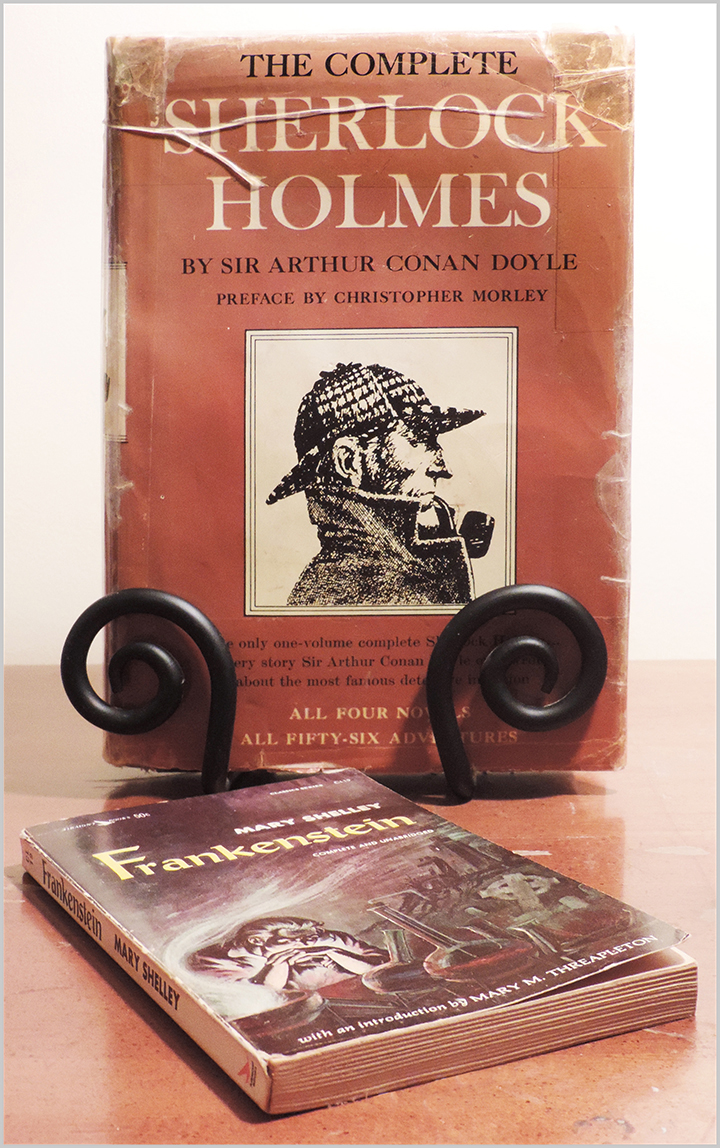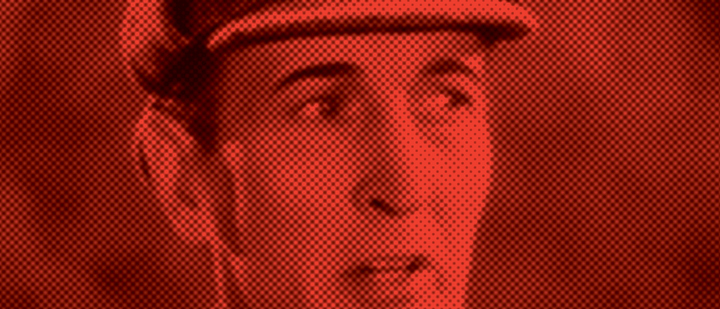
Getting into Wontner
‘The Sherlock Holmes Vault Collection’
The Film Detective
$59.95 (Blu-ray), $49.95 (DVD)
Five hours and 2 minutes plus special features
Not rated
By Mark Voger, author
“Holly Jolly: Celebrating Christmas Past in Pop Culture”
I’m a Sherlock Holmes freak. It’s Basil Rathbone‘s fault. When I was in grade school, Channel 48 in Philly showed a Basil Rathbone Sherlock Holmes movie every Saturday night at 11. They called it “Mystery Theater,” but it was always a Rathbone Holmes — no Charlie Chan or whoever.
OK, so there’s 52 weeks in a year. Channel 48 showed 13 of the 14 Rathbone Holmes films over and over and over, for maybe three years! That’s four times per year for each of the films. I memorized these movies, yo!
Anyways, the movies entered my bloodstream. My very favorite book in the world is an edition of “The Complete Sherlock Holmes” by Sir Arthur Conan Doyle published by Doubleday & Co., Inc. My parents gave it me for Christmas in 1972. It’s on my bedtable this very moment. I have a special stand for it. (Scroll to the bottom to see it.)
In my humble opinion, the greatest Sherlock Holmes of the movies is Basil Rathbone. Nobody else ever caught Holmes’ supreme, infernal arrogance. And I love, love, love Nigel Bruce as Dr. Watson, despite his comedic approach. (Go s*** in yer hat, Holmes purists.) And Mary Gordon as Mrs. Hudson. And Dennis Hoey as Inspector Lestrade. (That was all from memory. No googling. And believe me, the old brain is going.)
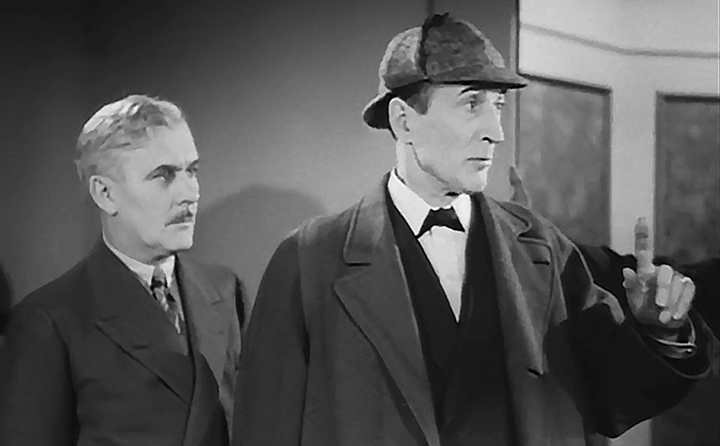
But I’ve always noticed that a lot of Holmes-philes award that distinction to Arthur Wontner, who played Conan Doyle’s great sleuth in five movies. While my fealty to Rathbone is unshakeable, I am open to any and all recommendations, especially from the olden days.
Cue “The Sherlock Holmes Vault Collection,” which is out this week. The new four-disc boxed set presents restored versions of four 1930s Sherlock Holmes films (three of them starring Wontner) plus generous extra features. Interestingly, the three Wontner films all feature Holmes’ nemesis — the Joker to his Batman — Prof. Moriarty. In the fourth film, Holmes is played by Reginald Owen, remembered as Scrooge in the 1938 “A Christmas Carol,” and the admiral in “Mary Poppins.”
Following are the four films …
‘The Fatal Hour’ (1931)
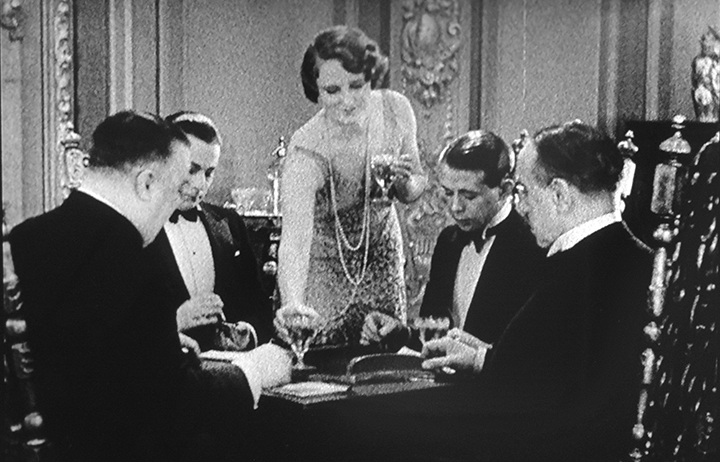
In Leslie S. Hiscott‘s “The Fatal Hour,” brother and sister Ronald and Kathleen Adair (Jane Welsh and Reggie Perrin) have been wiped out financially. Ronald, a civil servant, is replenishing their coffers via a suspicious lucky streak in high-stakes games of bridge. But Kathleen fears her brother has been cheating at cards, and asks a family friend, one Dr. John H. Watson (Ian Fleming) to intervene. Watson calls in his onetime Baker Street roommate … guess who?
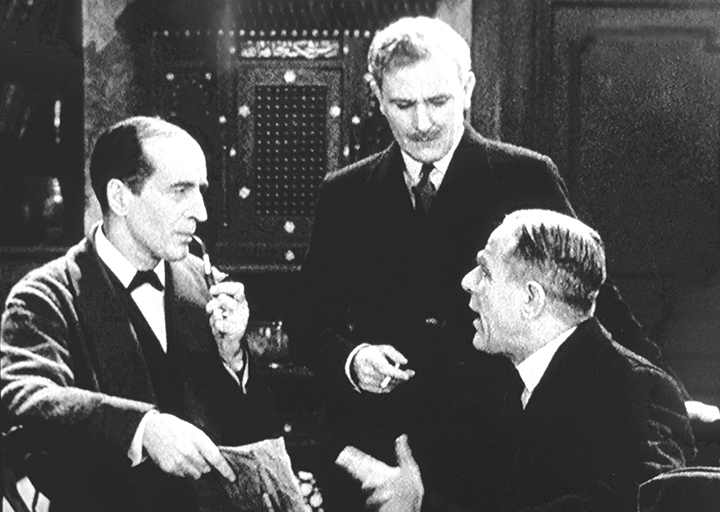
Meanwhile, Inspector Lestrade of Scotland Yard (Philip Hewland) once again seeks Holmes’ advice, this time in a seemingly unrelated case which has resulted in the death of a bank guard. Holmes sees the hand of Moriarty (Norman McKinnel) in the murder, something Lestrade, and even Watson, scoff at.
‘The Triumph of Sherlock Holmes’ (1935)
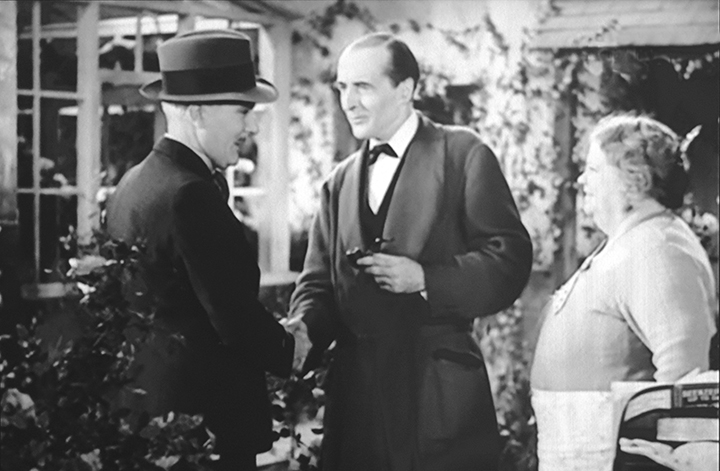
“Sherlock Holmes retires” cry the newspaper headlines in Hiscott’s followup. Holmes indeed relinquishes his practice to study bees in Sussex, while Dr. Watson relocates his medical practice to their old digs on Baker Street. When Moriarty (Lyn Harding) visits Holmes to wish him “a happy and permanent retirement,” you just know Holmes won’t be idle for long.
American gangster Ted Balding (Ben Weldon) enlists Moriarty to eliminate John Douglas (Leslie Perrins), Balding’s rival in the “Scourers,” a tattooed band of baddies who terrorized a region of America called the Vermissa Valley. Douglas’ wife, Ettie (Jane Carr), tells Holmes the whole sordid tale in a long flashback.
‘Silver Blaze’ (1937)
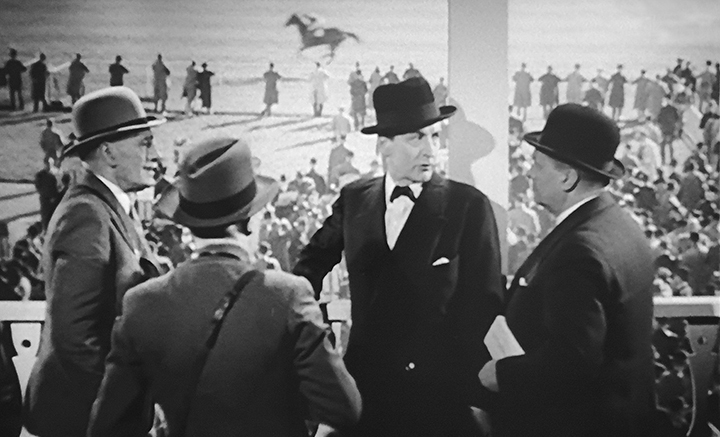
Also released as “Murder at the Baskervilles,” Thomas Bentley‘s “Silver Blaze” is a sequel of sorts to “Hound of the Baskervilles.” (I say “of sorts” because Wontner never filmed “Hound,” while his followers in the role Rathbone and Peter Cushing did.) Twenty years after the famous “Hound” case, Sir Henry Baskerville (Lawrence Grossmith) invites Holmes and Watson to his West Country estate for some rest and relaxation.
There’s a cute “meta” exchange between Sir Henry’s young daughter, Diana (Judy Gunn), and her fiance, Jack Trevor (Arthur Macrae). She: “Father asked Sherlock Holmes to come here for a few days.” He: “Why? The family hound come to life again?”
Holmes and Watson have barely sipped their first cocktail before shocking news arrives: A neighbor’s racehorse, Silver Blaze, has disappeared on the eve of an important race, and one of the horse’s minders (Ronald Shiner) was found murdered. Credibility Stretching Dept.: Inspector Lestrade (here played by John Turnbull) has been transferred from London to Exeter, and so is on the case.
‘A Study in Scarlet’ (1933)
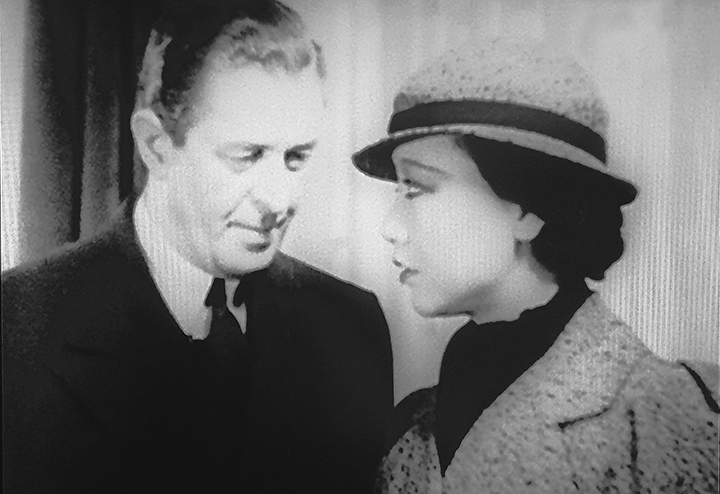
In Edwin L. Marrin‘s “A Study in Scarlet,” Sherlock Holmes of 221A Baker Street — um, it’s 221B in the Conan Doyle — is visited by the widow (Doris Lloyd) of a wealthy man whose death was ruled a suicide, and who left his fortune to a secret society. The group’s lawyer is well known to Holmes: Thaddeus Merrydew (Alan Dinehart), who earlier thwarted Holmes’ attempts to put him behind bars. When a second society member (Wyndham Standing) is murdered, Holmes questions his wife (Anna May Wong), who identifies Merrydew as her lawyer. Hmmm …
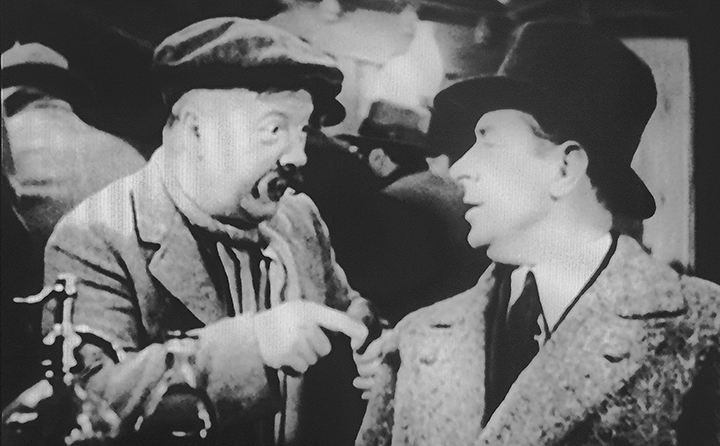
Geek alert! Three players in “A Study in Scarlet” later appeared in Rathbone Holmes films. Billy Bevan plays Will, a local who Holmes plies with booze to secure information and a buggy ride. Bevan played a constable in “The Pearl of Death” (1944) and a porter in “Terror by Night” (1946), both starring Rathbone as Holmes. Alan Mowbray, here playing Lestrade, played Col. Sebastian Moran in “Terror by Night.” Halliwell Hobbes, here playing a member of the secret society, was the butler in “Sherlock Holmes Faces Death” (1943). Hobbes probably played more butlers than Arthur Treacher!
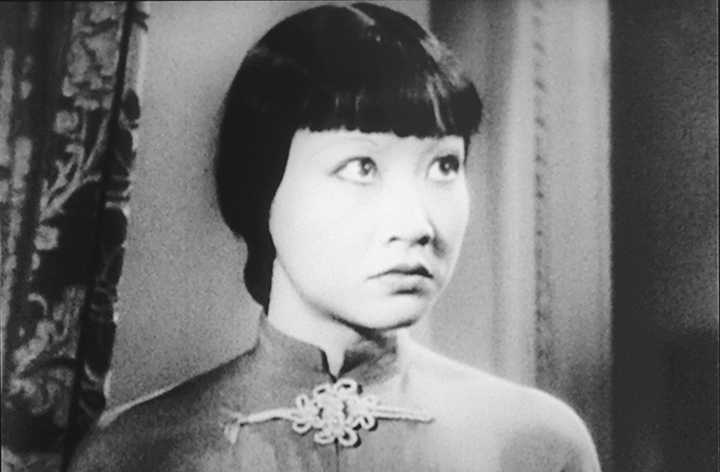
Wong, Hollywood’s first Chinese-American movie star, is a bright spot in the cast as the mysterious Mrs. Pyke. (Wong is second-billed after Owen, though hers is a fairly small role.) In a scene in which her housekeeper, Daffy Dora (Leila Bennett), describes Mrs. Pyke to Holmes, Dora gushes: “Such a good looker! Such eyes! She walks like a cat. Such a figure! Such a fine bit of goods.” (Sounds like a girl crush to me.)
As always, Wong wears her wardrobe well in “A Study in Scarlet,” and her bangs are fabulous. But nothing here hints at the splendor of “Daughter of the Dragon” (1931) or “Shanghai Express” (1932).
Rating Wontner and Owen
I can now call myself a fan of Wontner’s portrayal of Sherlock Holmes. He is playing an older Holmes here, and it comes off beautifully. I hope I get a chance to see the other two Wontner Holmes films before I shuffle off.
For me, fleshy Reginald Owen doesn’t look enough like Holmes. Conan Doyle’s character has that receding hairline … that sallow complexion … those chiseled cheekbones … that aquiline nose. (To be honest, I’ve only known the word “aquiline” as an adjective to describe the nose of Sherlock Holmes. Does anyone out there know what else it’s good for?)
Maybe the producers of “A Study in Scarlet” agreed with me that Owen needed to appear more Holmesian. The actor is often seen in a dressing gown, smoking a pipe or scratching on the violin, as if to remind you: This is Sherlock Holmes. That said, I find Owen’s portrayal highly entertaining.
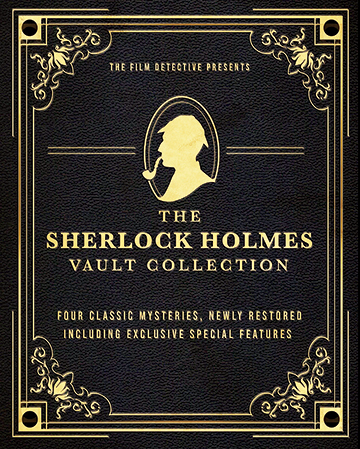 The boxed set
The boxed set
The four films, it should be noted, have been available as budget-priced public domain releases for decades, but in prints and audio of lamentable quality. (I already owned two of the Wontners myself, but the quality was so bad, I’ve never been able to finish watching them.) So it’s great to have these restored versions, especially with subtitles. (British slang spoken on 90-year-old soundtracks is hard to decipher in the best of circumstances.) However, The Film Detective’s print of “A Study in Scarlet” is, despite the restoration, still somewhat blurry and low-contrast-y.
As for those generous extras, there are six Holmesian (or Holmes-adjacent) shorts of wildly wavering entertainment value. These include “Sherlock Holmes Baffled” (1900), “The Copper Beeches” (1912), “Cousins of Sherlocko” (1913), “Slick Sleuths” (1926) and “Sure Luck Holmes” (1928). Because the surviving print of the comedy short “A Black Sherlock Holmes” (1918) is so profoundly damaged, it is presented in two edits, with one cut down to just its few watchable moments here and there. (I’m afraid I don’t know what to make of the short. There’s just not enough here for me to comment. Still, I’m glad they included it. I mean, it’s 103 years old.)
There’s also Ballyhoo Motion Pictures’ documentary titled “Elementary Cinema: The First Cinematic Adventures of Sherlock Holmes”; an audio “re-creation” of the radio play “Sherlock Holmes and the Blue Carbuncle” (with a seasonal nod to Christmas); a 1954 episode of the TV series “Sherlock Holmes” starring Ronald Howard (son of Leslie Howard), titled “The Case of the Blind Man’s Bluff”; and brief introductions by Samuel M. Sherman, producer of “Frankenstein vs. Dracula” and an expert on ancient movies. Hear also commentary by writers Jennifer Churchill, Jason A. Ney, Phoef Sutton, Mark Jordan Lega, Peter Atkins and David Breckman.
VIDEO
Above is The Film Detective’s trailer for the new boxed set.
Above is “Daughter of the Dragon” starring Anna May Wong. You’re welcome.
Above is my 1972 edition of “The Complete Sherlock Holmes” (it’s always on my bedtable), alongside my 1963 paperback edition of “Frankenstein” (which I’m currently reading). D’ya like my fancy stand for the Holmes book? Nothing but the best for my favorite volume!
